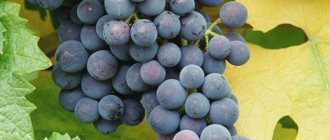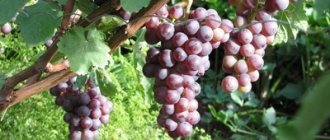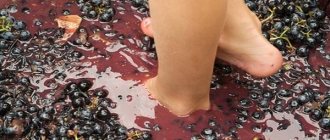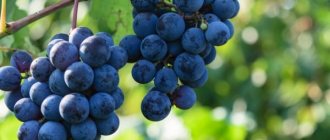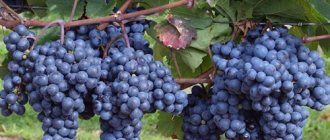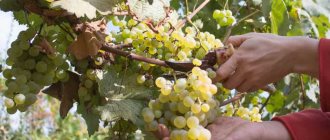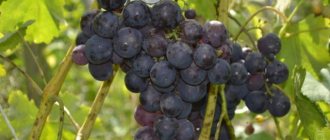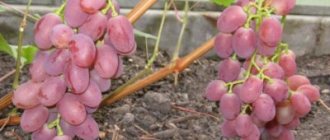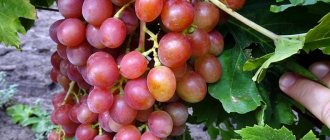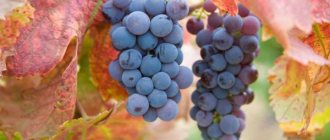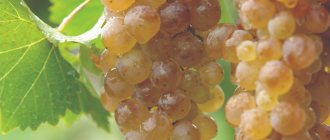What type does it belong to?
Kuban is a table grape variety with a fairly early ripening period of berries. The harvest ripens after 120-125 days from the growing season.
In the city of Novocherkassk, the harvest is harvested in mid-August. In colder climates closer to September.
Early ripening varieties also include Gordey, Elegant and Violet Ranny.
Like other table varieties, Kuban is valued for its excellent taste.
Most often, grapes are grown for fresh consumption, as well as for preparing homemade dishes, baking, and canning.
Amethyst, Aleshenkin's Gift and Athos are also good fresh.
Landing Features
If you want to grow good Kuban grapes, it is better to purchase a seedling in a specialized store. It is better to take the sprout immediately in a container, and when it grows, you can already practice with cuttings, layering or grafting. Choose a place for planting that is draft-free, sunny, and warm. You can choose a site near a wall or fence. But lowland areas are not suitable, because water often stagnates there and the humidity is high, which is dangerous in winter.
Important!
Grapes are primarily demanding on climate and soil type!
The planting pit is prepared a month in advance. Its depth is 80 cm, as is its diameter. Drainage 5 cm high is poured onto the bottom (required), and then another 10 cm of plain soil. The soil for planting is made from 2 buckets of plain soil, a bucket of humus and 100 g of complex mineral fertilizer (which contains nitrogen, phosphorus and potassium). Now you need to fill the hole well with water so that the soil settles and begin planting in a month.
The Kuban grape variety is not planted deeply, so that the root system is closed and the root collar is free from soil. Cover the bush with soil prepared in advance with the fertilizers described above! After planting, the soil is trampled down and watered.
Photo of Kuban grapes
Grapes "Kuban": description of the variety
- The bushes are characterized by a fast growth rate, strong trunk and branches. The leaves are light green, medium in size, with carved edges.
- The grape bunches are large. The average weight of the vine is about 700-900 grams , and some bunches up to 1.2-1.5 kg.
- The density is average, may be slightly loose, the shape is cylindrical-conical.
- The berries are large (approximately 3x2.5 cm in diameter), oval-ovoid in shape, 10-12 grams each.
- The grapes received a high tasting rating. The taste is harmonious, rich, sweet with slight sourness and a hint of nutmeg. The pulp is juicy, fleshy, aromatic. The skin is thin.
- Berries accumulate sugar well.
Ripe grapes contain at least 18% sugar content with an acidity of 5-6 g/l .
Ruta, Chocolate and Romeo also have a special taste.
Reviews from netizens
Greetings! This year I have my first fruiting in Kuban. The impression is twofold. Large lush bunches, large berries with a strong pruin coating. This is a plus. The flesh is fleshy, the seeds are felt immediately at the first bite. By the way, due to the size of the berry, you have to eat it in pieces. This is neutral. The downside is the taste. I expected more. The taste is simple - no frills, strongly reminiscent of Moldova, the acid goes away slowly, the sugar is normal, a little sticky in the mouth. Perhaps this is due to some overload, since my pity and common sense could not curb my greed and I left all the inflorescences for fruiting, and this is somewhere around 15 clusters weighing up to 1 kg. But, as they say, there is no arguing about tastes! There were no particular illnesses in Kuban, except that bacteriosis appeared slightly. In principle, if the variety is suitable for storage, then so be it!
Anatoly Bezin
https://forum.vinograd.info/showpost.php?p=28788&postcount=5
History of selection and region of breeding
The variety was obtained at AZOS (Anapa) from crossing the Cardinal and Moldova varieties.
This variety is also known as early Moldova. Sometimes gardeners confuse these varieties, although they are completely different in origin and characteristics. The variety has successfully passed tests and is suitable for cultivation in different regions of Ukraine, Russia, and Moldova.
Characteristic
- The bushes bring annual abundant harvests, especially when grown in the southern regions. It is worth noting that 55-60% of the shoots are fruitful. According to research, the fruiting coefficient is 1.0-1.2.
- When growing grapes, the gardener needs to pay attention to recommendations for the load on the bush. For this variety it is about 35-40 eyes per bush.
After the fragmentation, the number of green shoots should be 30-35 pieces . The recommended load will improve the quality of the harvest and help avoid breakage of branches due to overload with berries. - Kuban is often valued for its good commercial qualities. The berries are easy to transport. With proper transportation and storage, they do not crack, crumble or lose their appearance. After ripening, the grapes can remain on the bushes for some time without losing their taste.
- The frost resistance of the variety is average. Bushes can withstand up to -20 -23 degrees below zero.
However, in our climate, gardeners need to take care of reliable shelter for the winter, since grapes in our country are recommended to be grown as a cover crop. The plant is thermophilic and will not survive sudden temperature changes or frosty winters.
Heat-loving varieties also include Hadji Murat, Montepulciano and Arsenyevsky.
Growing grapes in Kuban. Growing seedlings at home
The vegetative method involves growing grapes using spring, summer, and winter cuttings. For high-quality grape breeding, it is necessary to properly prepare the cuttings (chubuks). Chubuki are ready-made cuttings that have one or five buds. Growing grape seedlings using the vegetative method does not affect the taste of the fruit. This method of enlarging vines is reliable for producing good quality seedlings. The result of the idea to get delicious grapes depends on the step-by-step execution of the instructions.
The preparatory phase of breeding of chubuks includes:
- Cutting pipes.
- Storage of workpieces.
- Preparing to grow vines.
Autumn is a favorable period for cutting grapes. With the onset of cold weather, when the leaves of the plant fall off, gardeners begin cutting the vines. For high-quality propagation of chibouks, medium shoots are taken from the top of straight vines from the fruiting branches of grapes. After cuttings are completed, they are soaked in a bucket for a day and sent for storage.
Then each cutting is taken out of the water, labeled, sorted into a bunch and wrapped in a damp rag, and sent for storage in the refrigerator or cellar. At 100% humidity, the storage temperature is - +4°C. The safety of the chibouks is periodically checked to ensure that mold does not appear and buds do not open earlier.
From the second month of spring, the cutting process continues; for this, the seedlings are thawed and tested for viability. A cross-section is made with pruning shears; when drops of water appear, they are defrosted further. The lack of water indicates dried seedlings, and digging means that it is rotten. Take the workpieces out of the refrigerator, wash them in cool water, and disinfect them in manganese for 6 hours. Then the sections are renewed, and the cuttings are left in clean water for two days.
The color of the cut matters – light green without black dots. For active growth of the root system, a root formation stimulator is added to the water.
The stage of growing cuttings at home continues.
The stems are planted in disposable cups or bottles in order to better observe the development of sprouts. Some gardeners practice planting chubuks in boxes, other containers, or directly into the ground, so as not to disturb the roots of the plant again.
Mini piggy pig. Features, care and price of mini pigs
Winter cuttings, after treatment with a stimulant and planting in greenhouse conditions, take root up to 90 percent. During the growing season, the shoots reach 1.5 meters; by the end of the first year, the roots grow up to 30-40 cm long. Only in the autumn of the second or spring of the third year are seedlings planted in open ground in a permanent place.
Diseases and pests
The variety is highly resistant to mildew and gray rot ( 3-3.5 points ). Despite this, grapes are very vulnerable to common diseases and pests.
Do not neglect the prevention of anthracnose, bacteriosis, chlorosis, rubella and bacterial cancer and adhere to proper grape care.
- Kuban is a favorite delicacy of wasps. To protect the berries, it is recommended to use special baits, traps, pollinate with chemicals, and also promptly destroy wasp nests near the site.
Carefully care for the soil: water abundantly, loosen the soil, remove weeds. Collect and destroy old dry leaves and fallen berries in a timely manner. This is a real breeding ground for bacteria and dangerous pests for grapes.
- Trim your grapes twice a year. The first occurs in autumn, and the second in spring. Carefully inspect the bushes, remove dried old branches.
- For preventative purposes, spray the bushes with special chemicals. This will help avoid pest attacks.
Kuban is a favorite variety of many gardeners. It attracts attention for its decorative qualities, easy care, and resistance to diseases and pests.
The grapes have a good presentation and rich taste. With proper care, the bushes will delight you with abundant harvests every year.
High yields are also demonstrated by Rkatsiteli, Anniversary of the Kherson summer resident and Gift of Magarach.
How to plant grapes correctly in the Krasnodar region. Rules of care
Even in the fertile Krasnodar region, wine berries produce good harvests only with the correct agricultural technology. We'll tell you how to grow grapes correctly.
The plant requires watering, pruning and rationing of bunches; garter; pest and disease control.
Caring for rooted bushes begins with removing the coverings and tying the vine to a support. Do this until the buds swell. Do not tie the shoots in a bunch - this will create thickening in the future. Shoots grow regularly, gartering is done as needed. In the first year you can get by with a peg for each bush, but in the second you will need a full-fledged trellis. The bush is formed in the form of a fan or led into one trunk.
The soil around the roots is well loosened, letting in oxygen. They apply nitrogen fertilizers, preferably organic matter. Well watered. Watering is necessary abundantly: per season - 4 times, one and a half buckets of water for each bush. Can be combined with fertilizing.
The soil around the bush is mulched with sawdust, wood chips or covered with black film. This will retain moisture and prevent weeds from spreading. In summer, unfruitful shoots need to be removed from the leaf axils; they deplete the plant. They no longer feed with nitrogen; now they use potassium. Fertilizers are applied before flowering and ovary formation.
Proper formation of a grape bush includes the spring removal of young, not yet lignified shoots, pinching and pinching. Without these techniques, the vine will become depleted and the berries will grow small. Each shoot should be left with about 10 leaves.
There will be pruning to be done in the fall. After leaf fall, at least half a month should pass. During these weeks, nutrients flow from young shoots to older ones, as well as into the root system. This process will end in October-November, then they will begin pruning. Leave more shoots - just in case, it is better to remove the extra ones in the spring. Then the grapes are treated against pests and diseases and covered for the winter. Winter in Kuban, although it lasts no more than a month and a half, can be cold. Therefore, grapes are covered, for example, with agrofibre.
“Christina” - the meaning of the name, the origin of the name, name day, zodiac sign, mascot stones
